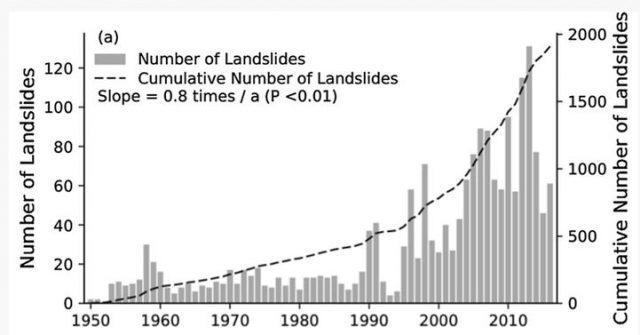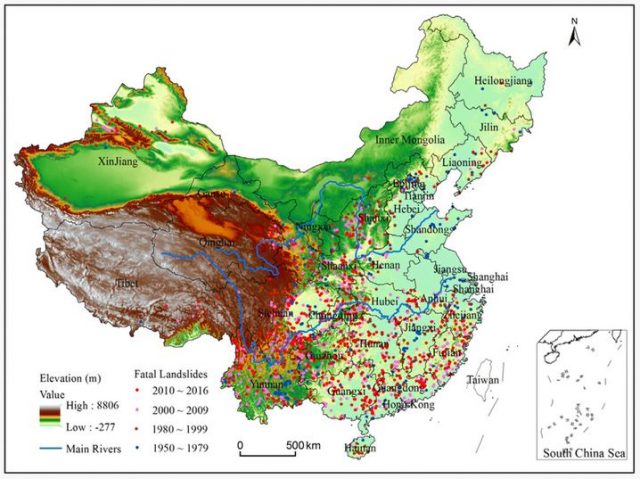20 July 2018
Losses from landslides in China – a new study
Posted by Dave Petley
Losses from landslides in China – a new study
One of the great challenges of compiling my fatal landslide database has been properly capturing losses from landslides in China. That country has a high incidence of landslides – indeed if one includes earthquake triggered landslides it probably suffers the highest annual losses of any country – but both the challenges of a character-based language and a lack of media freedom has made it difficult to collect information. In a new study just published in the journal Landslides, Lin and Wang (2018) have compiled a fatal landslide inventory from 1950 to 2016, and they provide a detailed analysis. This is a really important contribution to our understanding of the costs that landslides impose on society globally. The dataset specifically excludes landslides triggered by earthquakes.
The resulting stats are interesting. Over that period they recorded 28,139 deaths in 1233 fatal landslide events. As is usually the case with databases constructed retrospectively, the annual loss from landslides shows a substantial increase from about 2000 onwards:-

The annual number and cumulative total of fatal losses from landslides in China. Graph from Lin and Wang (2018).
.
This increasing trend is probably a consequence of a combination of better recording (most notably the availability of the digital media) plus an actual increase in landslide events. Interestingly, there is an apparent sharp increase year on year from about 1994 through to 2007; thereafter losses have stabilised (but vary greatly from year to year). The paper demonstrated a very strong seasonality in landslide events – as I showed in my paper a few years ago (Petley 2012). The spatial distribution of losses from landslides is interesting too though – the study shows that landslides occur extensively in a belt that runs alongside the south-eastern coast, stretching about 500 km inland, and also in the mountainous terrain in central China.

The distribution of losses from landslides in China. Figure from Lin and Wang 2018.
The paper analyses the potential drivers causing landslides, and concludes that the key factors are rainfall and vegetation (as measured by NDVI). But they have also undertaken a rather more sophisticated analysis, looking at the role of combination of factors. Interestingly, the most important combination is elevation and precipitation (this is reassuring), but they also find key factors in combinations of precipitation and soil type, slope, lithology, vegetation type and population density.
Overall, this is a really interesting and important contribution. Whilst the general pattern of landslide losses in China was already known and understood, Lin and Wang (2018) have provided a depth of understanding of losses from landslides in China that has been lacking.
Reference
Lin, Q. & Wang, Y. 2018. Spatial and temporal analysis of a fatal landslide inventory in China from 1950 to 2016. Landslides. https://doi.org/10.1007/s10346-018-1037-6
Petley, D.N. 2012. Global patterns of loss of life from landslides. Geology 40 (10), 927-930.


 Dave Petley is the Vice-Chancellor of the University of Hull in the United Kingdom. His blog provides commentary and analysis of landslide events occurring worldwide, including the landslides themselves, latest research, and conferences and meetings.
Dave Petley is the Vice-Chancellor of the University of Hull in the United Kingdom. His blog provides commentary and analysis of landslide events occurring worldwide, including the landslides themselves, latest research, and conferences and meetings.
dobro